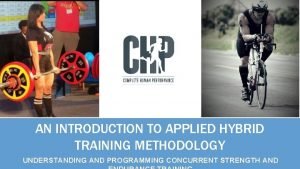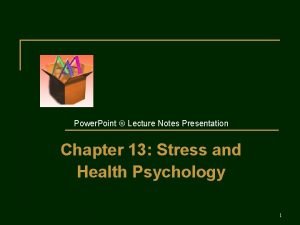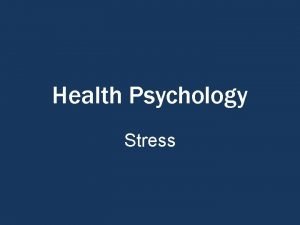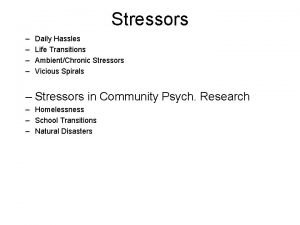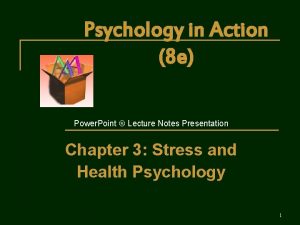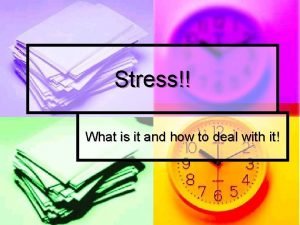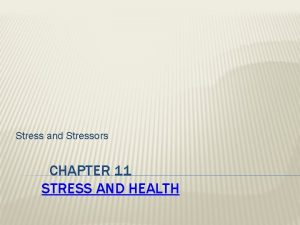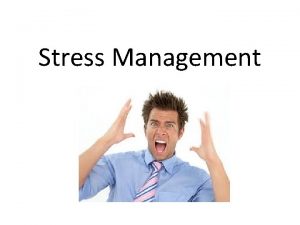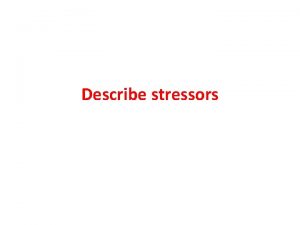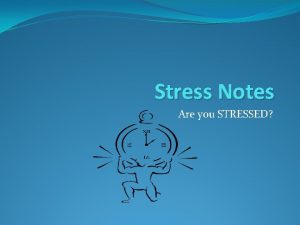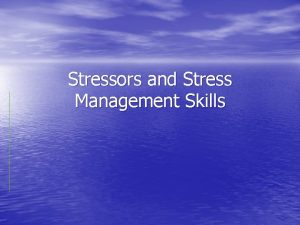STRESS 3 Stressors 1 The specification Stress as










- Slides: 10

STRESS 3: Stressors 1

The specification Ü Stress as a bodily response Ü The body’s response to stress Ü Stress-related illness and the immune system Ü Stress in everyday life Ü Life changes and daily hassles Ü Workplace stress Ü Personality factors Ü Psychological and biological methods of stress management 2

Outline of Today’s Session Ü Life changes Ü Daily hassles Ü Workplace stress 3

Life changes Research into as a source of stress Essay plan • Holmes and Rahe (1960 s) SRRS • The key feature of life changes is the psychic cost of change. • Individual differences • Research is correlational. • Bonanno et al (2007)

Life Changes: Rahe et al. (1970) Ü Aim? Ü To find out if scores on the Holmes and Rahe “Social Readjustment Rating Scale” (SRRS) correlated with subsequent onset of illness Ü How? Ü Used a version of SRRS with 2600 Navy men. Ü Showed? Ü A small positive correlation between illness and LCUs. Ü Retrospective recall may be unreliable. Ü Daily hassles may be better predictor Ü One reason may be that people are more likely to seek support for major life events (Flett et al. , 1995) 5

Psychological Resilience: Bonanno et al (2007) Ü What predicts psychological resilience after disaster? Ü How? Ü Ü Researchers asked one set of people about recent life events eg. death of a spouse Asked second set about how they had been affected by the September 11 th, Ü Ü Result? Ü Ü Ü Also measured whether the interviewee had PTSD Those who had experienced less life events were better able to cope with the disaster. Those with only 1 recent life event were 2 times more likely to be resilient than those who experienced 2 or 3 recent life events. Finding suggest Ü Ü effects of stressful events are cumulative the more bad things happen the worse people become at coping 6

Daily hassles as a source of stress Ü Anita De. Longis et al. (1982) hassles and uplifts scale. Ü May be due to accumulation or amplification (increased vulnerability). Ü De. Longis et al. (1988) How? 75 married couples Showed? Hassles were related to ill health (not life changes or uplifts). Ü 2 nd study? • Individual differences. • Research is correlational. • Retrospective recall may be unreliable. • Better than life changes.

Workplace stressors Ü Sir Michael Marmot (1977) How 7000+ civil servants (Whitehall study). Measured health status. • Work underload (Schulz et al. ) Five years later Ü WORKLOAD Ü CONTROL Ü It was not the hard- Ü Stress-related working executives most at risk of heart attacks; it was the people at the bottom of the hierarchy. illness was found in those who had felt the least control. • Individual differences. • Methods of assessment may be outdated. • Important real-world applications.

Mr Harris is about to move his business into a brand new building. He is very keen to create a healthy working environment and reduce workplace stress. In this way he hopes to improve productivity and reduce absenteeism. Exam questions What advice would you give Mr Harris? Use your knowledge of psychological research in this area. (6 marks) Jan 2010

The exam How Show What is meant by …. (3 marks) Describe one research study that has investigated …. . (6 marks). Describe and evaluate research … (6 marks + 6 marks) 3 studies /explanations 3 evaluative points 10
 Consolidation of stressors
Consolidation of stressors Walter cannon observed that a variety of stressors trigger
Walter cannon observed that a variety of stressors trigger Types of stressors life orientation
Types of stressors life orientation Stressors
Stressors Ambient stressor
Ambient stressor Walter cannon observed that a variety of stressors trigger
Walter cannon observed that a variety of stressors trigger Life stressors
Life stressors Upper specification limit and lower specification limit
Upper specification limit and lower specification limit Upper specification limit and lower specification limit
Upper specification limit and lower specification limit True strain equation
True strain equation Normal axial stress
Normal axial stress
